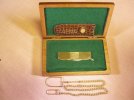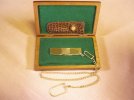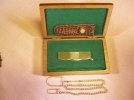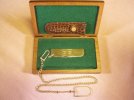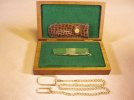In years past I was a patent illustrator producing those strange, semi-artistic multiple view illustrations you see accompanying patents. I drew them by hand first in a pencil first draft, and then with black india ink on Bristol board, adding the title text identifying the views and the attorney's detail numbers as presented in the detailed description from the body of the application. I worked for the attorneys in preparing the patent applications for their clients on items as mundane as knife sharpeners and fishing lures, to chemical processes, nuclear reactors, hip joint replacements, prothesis for cancer patients and complicated laser applications.
I had to learn to read the legal portions, a very dry, set form of writing which refrains in it's entirity from speculation and lore. Only clear facts were allowed, lest the patent examiner reject the application. A rejected application could be ammended and refiled, but at a cost of time and expense to the attorney and client.
Another requirement to a patent application was to list "prior art", previously known allowed patents which show the current state of the art in the immediate field of the client's application. And then to show in text and illustration how and why the new invention is an improvement over the prior art. In both text and illustration, it was often beneficial to the applicant to make the patent as broad as possible with as many reasonable, provable claims as possible to acquire the most offensive and defensive rights for the patent. Thus one invention patent may have two, three or more embodiments in addition to the preferred embodiment.
I believe this knife, which I at first simply called the "mystery knife", is another embodiment of the Williams-Sargent knife or, as we collectors like to call it, another variant, sharing all of the important details of the first shown / known invention with differing in minor details.
However, opinions, beliefs, possibilities are really a moot point when examining facts. Since this knife (which I now refer to as the MDS knife in defference to the monograms repeated on knife and purse, and in keeping with my calling the first known CPC for it's markings) has come to light, several facts have emerged. Taken as a whole, they point to the knife and purse being an original assembly custom marked for it's original owner. That the knife's monogram is conclusively translated on this knife by the expanded monogram on the purse, "M.D. Stone" casts doubt in my mind as to the modern accepted translation of the monogram on the CPC knife. There is nothing about the knife that calculates, though Sargent's title "Perpetual Calendar" suggests that is a part of the meaning of "CPC", is it? And where do we find a reliable reference that adds "Calculating"? So far in the discussions, discourses and rants that I have read on the CPC knife and the MDS knife, the only authoratitive reference cited has been this issue of Sargent's book which gives very little support to the information offered as fact about the knife.

I am willing to discuss this further with rational, reasoning adults who are interested. Please check your egos and insults at the door.
Michael


